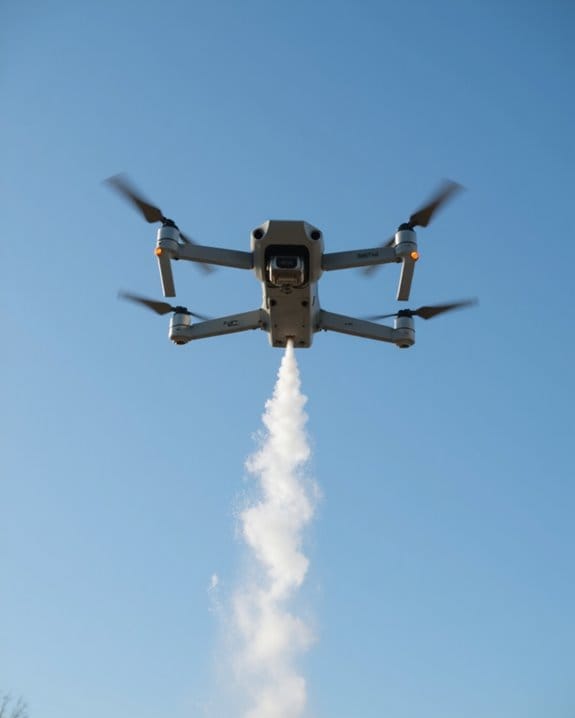You’re spotting more drones in the night sky in 2021 because they’re now used for everything from police search-and-rescue to industrial inspections, nighttime photography, and light shows. New FAA rules require anti-collision lights visible up to three miles, boosting both safety and visibility. Most drones at night have GPS, obstacle sensors, and powerful cameras, so they’re hard to miss. If you’re curious about regulations, safety, or why neighbors might feel uneasy, the details ahead will shed more light.
Key Takeaways
- Law enforcement and emergency services use drones at night for search and rescue or monitoring large events.
- Companies deploy drones after dark to inspect industrial sites using infrared and night vision technology.
- Hobbyists and professionals fly drones at night for unique photography, videography, and organized drone light shows.
- Advances in drone technology, such as anti-collision lights and obstacle avoidance, enable safer and more common night operations.
- Increased nighttime sightings in 2021 sparked privacy and security concerns, though most incidents were harmless or misidentified objects.
Common Reasons for Nighttime Drone Flights
When you look at the sky after dark, there are several key reasons why drones might be buzzing overhead. Both commercial and recreational drone operations take advantage of night flights for various tasks. Here’s what you might see:
Common Uses for Drones at Night:
- Safety & Surveillance: Local law enforcement often relies on flying at night for search and rescue or monitoring large events.
- Commercial Inspections: Companies deploy drones at night to inspect industrial sites, leveraging improved visibility with infrared cameras.
- Creative Purposes: Hobbyists use drones at night for photography and videography, capturing unique nightscapes.
- Entertainment: Drone light shows are growing, providing eco-friendly entertainment alternatives.
The FAA’s updated guidelines in 2021 made night flying more accessible, but required anti-collision lights for safety. Many of these drones are equipped with night vision capabilities such as advanced low-light sensors and stabilized gimbals to capture clear footage in darkness. So, next time you spot drones at night, it’s likely for a good reason!
Key Regulations Governing Night Drone Operations
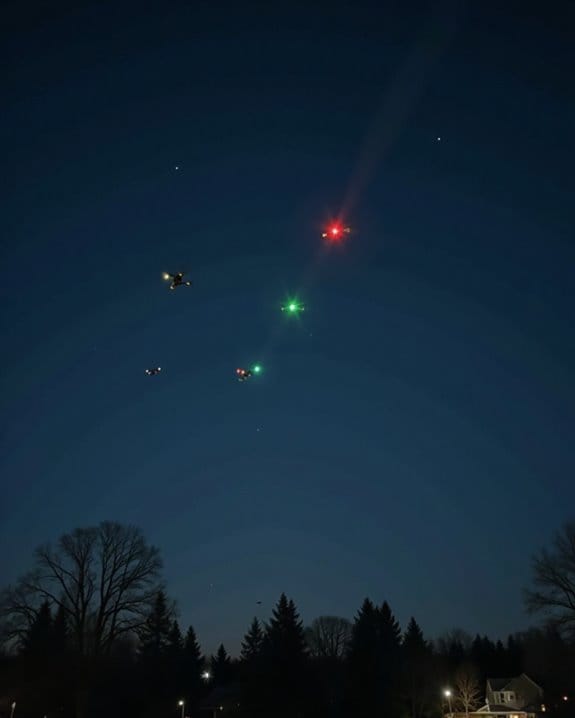
Spotting drones in the night sky isn’t just about marveling at their purpose—it’s also about knowing they’re following strict rules. If you’re flying a drone after dark, you’ll need to comply with several region-specific regulations:
United States (FAA rules):
- All drones must have anti-collision lights visible for at least three miles.
- Pilots must stay within visual line of sight.
- Night is defined as 30 minutes after sunset until 30 minutes before sunrise.
- FAA-certified pilots from before 2021 need updated night-operation training.
United Kingdom:
- Drones must have at least one green flashing light for visibility.
- Pilots are required to maintain visual line of sight at all times.
Canada:
- Drones need visible lights and must be flown below 122 meters.
- Visual line of sight is mandatory.
Additionally, many drones flying at night are equipped with night vision capabilities to enhance their operational safety and visibility.
Essential Safety Measures for After-Dark Flights

Curious how to keep your drone flights safe after sunset? For any Night Drone operation done at night, you’ll need more than just nerves of steel—bright lights are a must. The FAA mandates anti-collision lights visible from three miles away to boost public safety and security and help you avoid air traffic. As a Remote Pilot, always perform a thorough risk assessment before takeoff. Verify your drone is registered with the FAA and that you’ve completed night operations training if certified before 2021.
Key safety specs:
- Maintain visual line-of-sight (VLOS)—no Beyond Visual flights.
- Use obstacle avoidance sensors and GPS-enabled return-to-home.
- Stay below 122 meters in Canada or 120 meters in the EU.
Professional drone operators: Following these steps keeps everyone—people, property, and pilots—safe after dark. Many modern drones also include dual-axis gimbal stabilization to enhance flight stability and safety during low-light conditions.
Technological Advances Enabling Night Drone Use
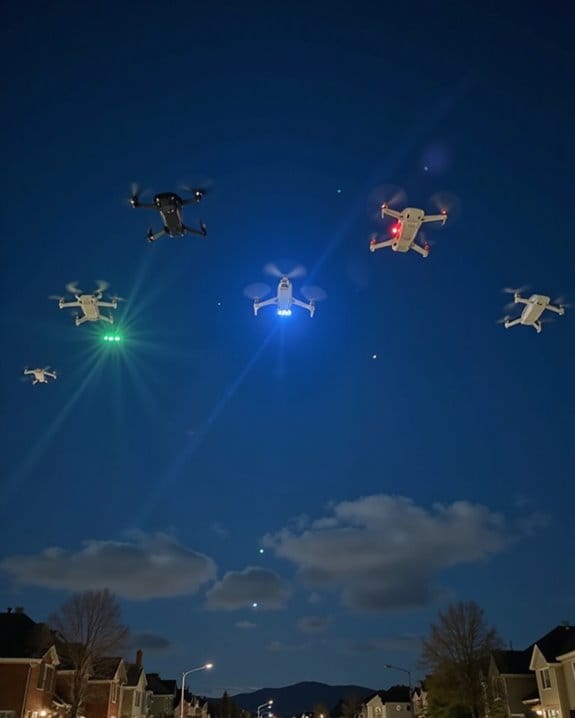
Ever wonder how drones manage to navigate the inky darkness with such confidence? Thanks to rapid technological advances, drone flights at night are now both safer and more effective. In 2021, FAA regulations required anti-collision lights visible for up to three miles, making Drones Flying in the night sky much easier to spot—especially in the busy National Airspace. Modern drones connect to at least six satellites, giving them reliable GPS and return-to-home functions for nighttime flights.
Key technological upgrades include:
- Obstacle avoidance systems using infrared and ultrasonic sensors, minimizing mid-air mishaps during drone activity.
- Advanced cameras with manual aperture controls (f/2.8–f/4.0) and high ISO ranges (1600–6400), capturing clear footage despite low light.
- Compliance with civil aviation standards, reducing reports of drone accidents.
That’s why Flying Drones after dark isn’t just for sci-fi anymore.
Public Concerns and Privacy Considerations
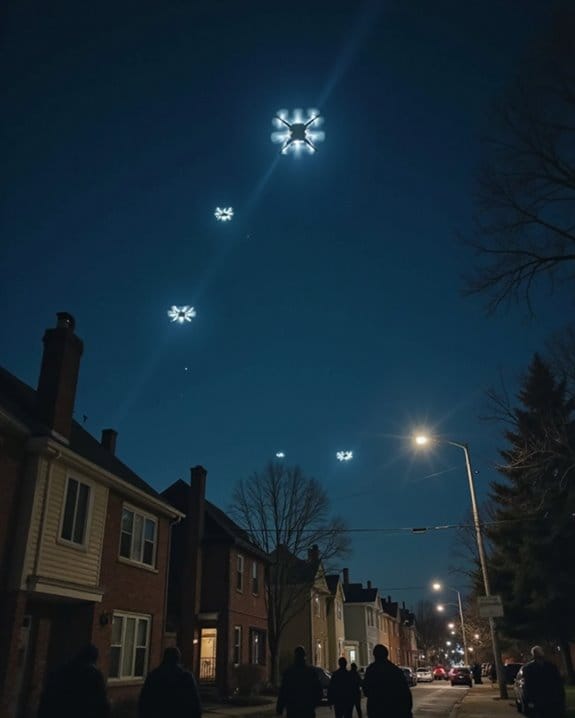
How much privacy can you really expect when drones start buzzing overhead after dark? In 2021, the surge in unidentified drone sightings raised immediate questions for people on the ground. With mysterious flying objects equipped with high-powered cameras and infrared sensors, you might wonder who’s watching—and why. Recent sightings of unauthorized drones have many citizens worried about their privacy and national security, especially since there’s no easy way to know a drone’s purpose. The lack of clear identification requirements means you often can’t tell if a drone is commercial, hobbyist, or government-operated. Advocacy groups argue that these issues pose a public safety and privacy risk. If you’ve reported seeing a drone at night, you’re not alone—public concern remains high, and the need to know is greater than ever.
Notable Incidents and Misidentifications
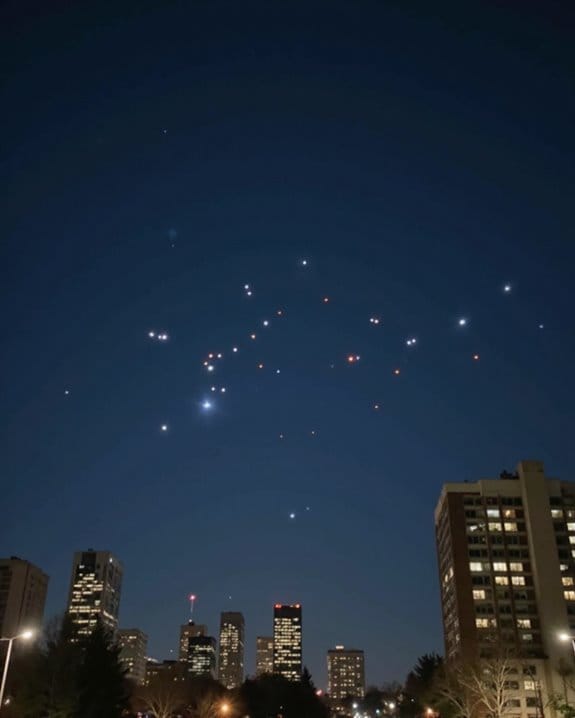
Mistaken identity is at the heart of many “drone sightings” reported at night in 2021. You might be surprised to learn that objects mistaken for drones included manned aircraft, satellites, and even planets. In regions like New Jersey and New York, federal officials found that many reports matched the flight patterns of crewed aircraft departing local airports. The FBI is leading several investigations and has determined that most sightings pose no real threat, as they’re often the result of confusion, not actual drones used illegally.
Notable incidents often involved hobbyist drones or routine law enforcement flights, which were misreported due to increased media coverage. When leading the investigation, federal officials stressed that birds, stars, or distant lights are frequently mistaken for drones, fueling unnecessary concern.
Frequently Asked Questions
Why Are There Drones Flying Around at Night?
You’ll often spot drones at night because pilots can now legally fly after dark with proper training and lights. They’re used for security, inspections, photography, and rescue, thanks to improved technology and updated safety regulations.
How to Tell if a Drone Is a Police Drone?
Ever wonder if that drone above is police-operated? Look for bright anti-collision lights, steady hovering over public events or crime scenes, and coordinated patterns. Police drones often lack visible Remote ID signals and may use infrared sensors at night.
How to Tell if a Drone Is Watching You at Night?
You’ll know a drone’s watching you at night if it hovers nearby with visible anti-collision lights, makes a distinct buzzing sound, or circles your area. Check for infrared lights and use apps to identify its operator.
What State Are the Drones Flying Over?
You’d think the whole East Coast’s turning into a sci-fi movie set! You’ll find drones flying over New Jersey, New York, Connecticut, Pennsylvania, Massachusetts, and Virginia—so keep your eyes peeled if you’re in these states.


